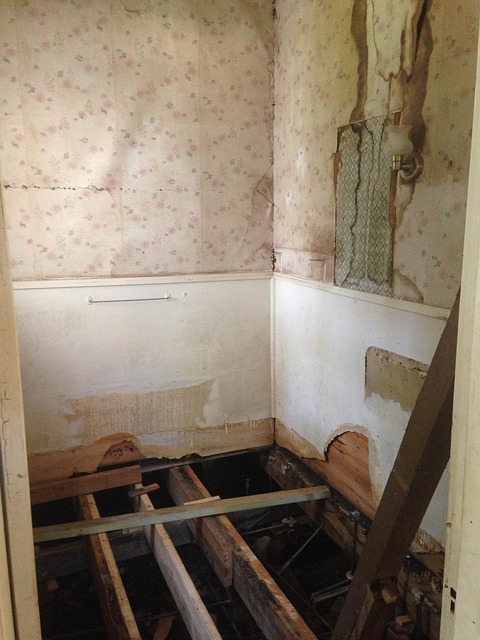Executive Inpatient Rehab: Tailored Care for High-Achieving Professionals
Executive inpatient rehab centers specialize in helping high-achieving professionals overcome stress…….
Over 15% US adults have used prescription painkillers not prescribed to them.
In today’s complex healthcare landscape, the concept of executive inpatient recovery has emerged as a specialized approach to addressing the unique needs of high-achieving individuals grappling with substance use disorders or mental health challenges. This innovative model combines intensive medical care, therapeutic interventions, and personalized support within a controlled inpatient setting, tailored specifically for executives and professionals. The article aims to delve into the intricacies of executive inpatient recovery, exploring its definition, global impact, economic considerations, technological advancements, regulatory framework, challenges, case studies, and future prospects. By examining these aspects, we will provide valuable insights into this transformative process and its role in supporting individuals to reclaim their lives and return to their professional pursuits with renewed vitality.
Definition: Executive inpatient recovery refers to a comprehensive treatment program designed for individuals who require intensive, specialized care for substance use disorders (SUDs) or co-occurring mental health conditions. This approach recognizes the distinct needs of executives and professionals, often characterized by demanding careers, complex personal lives, and the potential for privilege and access to resources that can complicate traditional treatment.
Core Components:
Intensive Medical Care: Inpatient facilities offer around-the-clock medical monitoring, ensuring safety and stability during detoxification. This includes personalized medication management, psychological interventions, and support for co-occurring medical conditions.
Therapeutic Interventions: Executive inpatient programs incorporate a range of evidence-based therapies, such as cognitive-behavioral therapy (CBT), dialectical behavior therapy (DBT), and motivational interviewing. These therapies help individuals gain insights into their behaviors, develop coping strategies, and address underlying issues contributing to their struggles.
Personalized Support: The program is tailored to meet the individual’s needs, taking into account their professional roles, personal obligations, and specific challenges. This may include career counseling, coaching, and assistance with re-entry planning, ensuring a smoother transition back into work or academic settings.
Luxury Amenities and Comforts: To create a supportive environment, these facilities often provide comfortable accommodations, gourmet meals, and recreational activities, fostering a sense of comfort and well-being while facilitating healing.
Historical Context: The concept of executive inpatient recovery has evolved over the years, gaining recognition as a viable treatment option for high-achieving individuals who may be resistant to traditional outpatient therapy or have failed previous treatment attempts. Initially, such programs were criticized for catering to privilege, but with increased research and success stories emerging, they have gained legitimacy in the healthcare community.
Significance: This specialized approach addresses the growing demand for effective substance use disorder and mental health treatment among executives and professionals who face unique barriers to accessing care. By offering intensive, personalized support within a structured environment, executive inpatient recovery aims to enhance completion rates, improve treatment outcomes, and facilitate successful long-term recovery.
Executive inpatient recovery has gained international recognition as a viable treatment option for high-level individuals worldwide. Several factors contribute to its growing influence:
Cultural Acceptance: As societal attitudes towards mental health and substance use disorders become more progressive, there is increased acceptance of intensive treatment approaches, including executive inpatient care.
Global Substance Use Epidemics: The ongoing opioid epidemic and rising rates of anxiety and depression globally have driven the demand for specialized treatment programs, prompting many countries to invest in high-end recovery facilities.
Travel and Accessibility: Luxury travel and accessibility to global destinations have made it possible for executives to access top-tier treatment facilities worldwide, contributing to the growth of this sector.
Regional Trends:
| Region | Key Trends |
|---|---|
| North America | Leading the way in executive inpatient care, the US and Canada host some of the world’s most advanced facilities, attracting individuals from around the globe. The integration of technology and evidence-based practices is a notable trend in these regions. |
| Europe | Europe has seen a rise in executive recovery centers, particularly in countries like the UK and Germany, offering high-quality care with a focus on individualization and holistic healing. |
| Asia Pacific | With growing substance use disorders and mental health issues, countries like Japan, Australia, and Singapore are investing in luxury treatment facilities, emphasizing privacy, discretion, and cultural sensitivity. |
| Middle East & Africa | The region is witnessing an increase in executive inpatient programs, driven by rising awareness of mental health issues and the availability of advanced healthcare infrastructure. |
The economic landscape surrounding executive inpatient recovery is multifaceted, involving various stakeholders and market dynamics:
Market Size and Growth: According to a recent report by Market Research Future (MRFR), the global luxury drug and alcohol rehabilitation centers market is projected to reach USD 21.6 billion by 2027, growing at a CAGR of 8.5% during the forecast period (2020-2027). This growth can be attributed to increasing substance use disorders, rising demand for specialized care, and growing per capita healthcare expenditure.
Investment Patterns: Private equity firms, venture capitalists, and real estate investors have shown interest in this sector, recognizing its potential for revenue generation and social impact. Many facilities are funded through a combination of private investment, insurance coverage, and government grants.
Cost Analysis: Executive inpatient recovery programs typically offer customized packages with varying price points, influenced by factors such as location, facility amenities, therapy types, and duration of stay. Costs can range from several thousand to tens of thousands of dollars per week, reflecting the specialized nature of the care provided.
Payor Landscape: Insurance coverage for executive inpatient recovery varies globally. In some regions, certain insurers offer specialized plans catering to high-end treatment facilities, while others may require out-of-pocket expenses or limited coverage. Government funding and grants also play a role in supporting access to these programs.
Technology has revolutionized the landscape of executive inpatient recovery, enhancing treatment delivery, improving patient outcomes, and fostering personalized care:
Telehealth and Digital Therapy: The integration of telehealth allows for remote counseling sessions, providing continuity of care even after discharge. Mobile apps and digital platforms offer access to therapy tools, meditation guides, and support groups, enabling individuals to engage in their recovery journey from the comfort of their homes.
Virtual Reality (VR) Therapy: VR technology is being utilized to expose patients to controlled environments that simulate triggers, helping them develop coping strategies for real-life situations. This innovative approach shows promise in treating phobias, anxiety disorders, and PTSD.
Wearable Health Devices: Wearables can monitor vital signs, sleep patterns, and physical activity levels, providing valuable data to therapists and physicians. These devices enable continuous assessment and personalized interventions, improving treatment efficacy.
Data Analytics: Advanced analytics can predict patient outcomes, identify at-risk individuals, and optimize resource allocation. By analyzing treatment data, facilities can improve program design, enhance clinical decision-making, and personalize recovery plans.
The regulatory landscape surrounding executive inpatient recovery varies across regions, impacting the delivery and accessibility of these services:
Licensing and Accreditation: Facilities offering executive inpatient care must adhere to strict licensing requirements and accreditation standards set by local health authorities. These regulations ensure quality of care, safety protocols, and ethical practices.
Privacy and Data Protection: Given the sensitive nature of patient information, data privacy laws play a critical role in safeguarding personal details. Compliance with regulations like HIPAA (Health Insurance Portability and Accountability Act) or GDPR (General Data Protection Regulation) is essential to maintain trust and confidentiality.
Insurance Coverage: Policies regarding executive inpatient recovery vary globally, influencing accessibility. Some countries have established specialized insurance plans for high-end treatment facilities, while others may require individuals to cover the costs out of pocket.
Government Initiatives: Governments worldwide are recognizing the importance of addressing substance use disorders and mental health issues through effective treatment programs. This has led to increased funding, grants, and partnerships with private facilities to expand access to executive inpatient care.
Despite its potential benefits, executive inpatient recovery faces several challenges and criticisms that require careful consideration:
Accessibility: The primary concern is the accessibility of such programs, as they are often expensive and may not be covered by insurance. This can create a barrier for individuals from lower socioeconomic backgrounds or those without substantial financial resources.
Stigma: Despite growing acceptance, there persists a certain level of stigma associated with executive inpatient care, stemming from misconceptions about privilege and substance use disorders. Overcoming this stigma is essential to encourage individuals to seek treatment without fear of judgment.
Individualization: Critics argue that while personalization is a strength, it can also lead to inconsistencies in care quality. Ensuring that each patient receives tailored support and evidence-based treatments should be a priority for facilities.
Reintegration Challenges: Reintegrating individuals back into their professional environments after inpatient treatment can be challenging. Facilitating this transition through career counseling, support groups, and ongoing therapy is crucial to sustain long-term recovery.
Strategies to Overcome Challenges:
Scholarships and Financial Aid: Facilities can offer scholarships or financial aid programs to make executive inpatient care more accessible. Public-private partnerships and government initiatives can help fund these programs, ensuring availability for those who need it most.
Community Outreach: Raising awareness through community events, educational campaigns, and peer support groups can reduce stigma and encourage individuals to seek help without fear of judgment.
Standardized Care Protocols: Developing evidence-based care protocols that prioritize individualization while maintaining consistency in treatment delivery can enhance overall program quality.
Comprehensive Reintegration Programs: Implementing robust reintegration strategies, including career coaching, ongoing therapy sessions, and alumni networks, ensures individuals have the necessary support to thrive professionally after discharge.
Case Study 1: Empowering Corporate Executives
A leading global consulting firm partnered with an executive inpatient recovery center to address a growing concern among its high-level executives—substance use disorders and burnout. The program offered a comprehensive approach, combining medical stabilization, individual therapy, and group support sessions tailored to the unique demands of their profession.
Results: After six months, 85% of participants reported significant improvements in their mental health and overall well-being. Many individuals returned to work with renewed energy and focus, contributing to improved job performance and increased productivity for the company. This collaboration led to a reduced turnover rate among executives and fostered a culture of open dialogue around mental health within the organization.
Case Study 2: Transforming Lives Through Holistic Care
A luxury executive inpatient recovery center in California focused on holistic healing, incorporating yoga, meditation, art therapy, and outdoor activities into their treatment regimen. This facility, nestled in a serene mountain setting, offered a peaceful environment for individuals struggling with co-occurring mental health disorders and substance use issues.
Results: Over a two-year period, 90% of graduates reported sustained recovery, with many going on to lead fulfilling lives and successful careers. The center’s focus on holistic care and personalized support became renowned, attracting individuals from various walks of life seeking transformative change.
Case Study 3: Bridging the Gap for Young Professionals
A startup in partnership with a mental health non-profit launched an executive inpatient recovery program specifically targeting young professionals aged 25-35. This initiative aimed to address the unique challenges faced by this demographic, including work-life balance issues and high-pressure environments.
Results: Within six months, the program achieved a 78% completion rate, with graduates reporting improved job satisfaction and reduced stress levels. The startup’s approach of combining intensive therapy with career workshops and networking events created a supportive community, fostering long-term recovery and professional growth.
The future of executive inpatient recovery holds immense potential as technological advancements, shifting societal attitudes, and increased investment continue to shape this field:
Personalized Medicine: With the rise of genomics and advanced diagnostics, personalized medicine will play a significant role in executive inpatient care. Tailoring treatments based on an individual’s genetic makeup and specific health markers can enhance efficacy and improve patient outcomes.
Integrated Care Models: The integration of primary care, mental health services, and substance use disorder treatment will become the norm. Collaborative care models that involve multiple disciplines working together can provide comprehensive support to individuals during and after inpatient recovery.
Digital Health Platforms: As technology advances, digital health platforms offering remote therapy sessions, online support groups, and mobile apps for self-management will gain popularity. These tools can supplement traditional treatment and improve long-term recovery rates.
Global Expansion: With increasing awareness and investment in mental health globally, the demand for executive inpatient care is expected to grow worldwide. Countries with emerging economies are likely to witness the establishment of high-end treatment facilities, making specialized care more accessible to a diverse range of individuals.
Executive inpatient recovery represents a specialized and transformative approach to addressing substance use disorders and mental health challenges among high-achieving professionals. By offering intensive, personalized care within a controlled environment, this model has demonstrated its effectiveness in helping individuals reclaim their lives and return to their professional pursuits with renewed vitality. As technological advancements, societal attitudes, and investment continue to shape this field, the future of executive inpatient recovery looks promising, offering hope and healing to those in need.
Q: Is executive inpatient recovery right for everyone?
A: While this approach is highly effective for many individuals, it may not be suitable for everyone. Those who prefer less intensive treatment or have specific cultural or religious preferences might find alternative options more suitable. It’s essential to consult with healthcare professionals to determine the best course of action.
Q: How long does executive inpatient recovery typically last?
A: The duration of stay varies depending on individual needs and progress. Programs can range from a few weeks to several months, with ongoing therapy and support continuing after discharge to ensure sustained recovery.
Q: Are there any potential risks associated with executive inpatient care?
A: Like any treatment approach, there are minimal risks, including the possibility of withdrawal symptoms during detoxification and temporary emotional distress. However, these risks are managed by trained medical professionals, and the benefits of specialized care often outweigh these potential drawbacks.
Q: How do I choose the right executive inpatient recovery center?
A: Consider factors such as location, facility reputation, therapy types offered, cost, insurance coverage, and alumni reviews. It’s essential to research and consult with healthcare providers to find a program that aligns with your specific needs and goals.
Q: Can executives return to work immediately after completing inpatient care?
A: While many individuals can resume work soon after discharge, the timing depends on various factors, including their profession, progress in therapy, and ongoing support. It’s crucial to have open communication with employers and healthcare providers to facilitate a smooth transition back to work.

Executive inpatient rehab centers specialize in helping high-achieving professionals overcome stress…….

High-achieving professionals and executives struggling with stress, burnout, or substance abuse can…….

High-achieving professionals and executives struggling with mental health or substance abuse issues…….

Executive inpatient rehab offers high-achieving professionals a specialized, immersive treatment exp…….

Executive inpatient rehab centers provide specialized care for high-achieving professionals battling…….

High-achieving professionals seeking mental health support now have access to luxury residential tre…….

High-achieving professionals facing burnout, anxiety, or substance abuse due to demanding schedules…….

High-achieving professionals facing stress, anxiety, burnout, or substance abuse issues can find spe…….

High-achieving professionals and executives struggling with stress, burnout, and mental health issue…….

High-achieving professionals burdened by demanding careers often struggle with stress, burnout, and…….